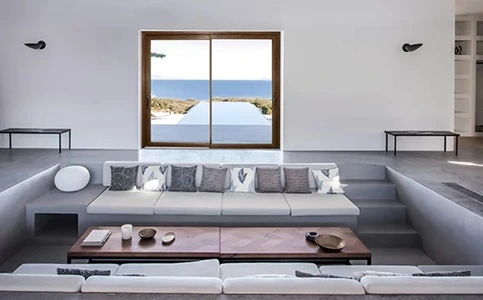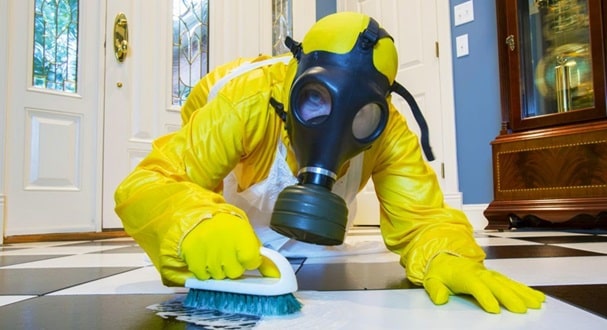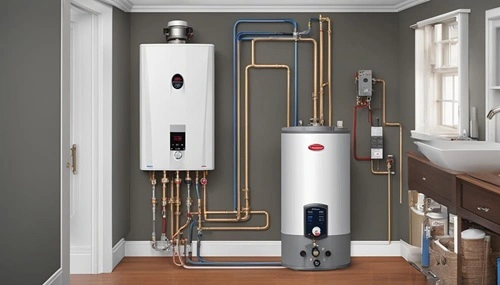In the process of determining which suitable windows to fit, top on everyone’s checklist are usually the uPVC windows. They possess the essentials of durability, efficiency in energy, and affordability. For so long, uPVC windows have slowly captured the hearts of house owners and builders due to their acceptance in modern homes. Despite this rising popularity, however, there are still numerous myths and misconceptions that influence decisions of potential buyers.
In this blog post, we will discuss 5 common myths about uPVC windows and dispel them with truth. Thus, by the end of it, you’ll have a clearer understanding of the benefits and limitations of uPVC windows so that you can make that informed choice when considering uPVC windows for your home.

What Are UPVC Windows?
uPVC windows have become popular windows whereby the frame is made from a strong and low-maintenance material called uPVC. Unlike ordinary wood or metal windows, uPVC windows offer functionality, longevity, and energy efficiency making them currently the more in-demand choice for residential as well as other commercial applications.
The material itself is rigid, meaning it doesn’t have to bear the characteristics of plasticizers, which gives uPVC those peculiar strengths—strength, durability, and resistance to elements. It’s also highly resistant to corrosion, weathering, and fading, which makes it an ideal material for window frames, especially in extreme weather conditions.
These windows are also readily available in double or triple glazing that considerably enhances their thermic capacity. Being an energy-efficient material, the uPVC window saves money when it comes to heating and cooling times and also less maintenance is required because of its long service life. Thus, uPVC windows would be a very ideal choice for home owners .
Features of uPVC Windows
Some of the most significant and impressive features of uPVC windows are as follows:
1. Durable and Strong: uPVC is resistant to corrosion, rot, and rust, and the material is also extremely tough. And it is further not prone to corrosion and weathering. Therefore, uPVC windows are very durable, and can withstand adverse environmental conditions such as UV, rain and snow.
2. Energy efficiency: uPVC is an excellent insulator. When matched with double-glazed or triple-glazed windows, it produces a more constant indoor temperature, requires less heating, and less air conditioning in the summer. It allows for substantial energy cost savings in the long term.
3. Low Maintenance: uPVC windows do not need much maintenance. No painting or sealing is required, unlike timber windows, which may deteriorate over time and require ongoing maintenance. They can usually stay in good shape just with soap and water.
4. Variety of Styles: uPVC windows come in quite a few different designs and styles casement, tilt-and-turn, sliding, and sash window styles, for example. They can be designed according to your taste so as to suit your home’s aesthetic; different colors and finishes, including wood-like textures, can be accommodated.
5. Security: uPVC windows are security based. Many variations have multi-point locking systems that provide additional strength in withstanding break-ins and burglaries. As such, they would offer protection to homes and commercial entities.
6. Noise Insulation: uPVC windows are said to reduce noise pollution. This is due to the solid structure and the two or three glazing sheets, which impart insulating properties. This is particularly useful for dwellings located in noisier areas.
7. Environment-Friendly: Although the manufacturing process of uPVC also carries an environmental implication, the product is recyclable. Several windows produced from uPVC are manufactured through eco-friendly production processes. Its durability and efficiency mean not changing or replacing often and saving energy.
8. Cost-Effective: Although the natural cost of uPVC windows may be different according to style and configuration, they are relatively inexpensive as compared to materials like aluminum or timber. Considering long-term energy-saving and minimal maintenance expenses, uPVC windows are a cost-effective option for homeowners.
Myth 1: uPVC Windows Get Discolored and Fade
The Myth
One of the common myths about uPVC windows is that they fade or, rather, discolor. Most people believe that, within a few years of exposure under the sun or harsh weather conditions, uPVC windows will eventually turn yellowish or just generally lose their overall appearance and look.
The Fact
It is also true that if older uPVC windows may have experienced color discoloration in the past, with improved modern technology in uPVC, the problem no longer exists. Today’s uPVC windows are made using such additives and grade materials that do not discolor or fade over time. Rather, uPVC windows are manufactured to handle extreme UV lights, pollutants, and their effect of harsh weather conditions without losing their color.
Secondly, most uPVC windows have a high gloss finish that maintains a dirt and grime resistant status, therefore ensuring that it will always maintain a pristine appearance for years to come. Provided you clean your uPVC windows from time to time using mild soap and water, they should look fresh for decades.
It’s a given that the colour will eventually fade and that, over time, uPVC windows themselves will degrade-you can bet they’ll remain a beauty for ages to come if kept clean and treated with care, it’s a long-term investment in your home.
Myth 2: uPVC Windows Are Not Energy Efficient
The Myth
This is one of the very prevalent myths about uPVC windows: they are not as energy efficient as some other materials, like wood or aluminum, for example. Some even think that uPVC is low quality in general and very inexpensive to boot, so it cannot possibly keep the house warm.
The Truth
On the other hand, uPVC windows are famous for their superior energy efficiency. The material itself is naturally insulating, so that it has a low thermal conductivity, or in other words, it does not lose heat as fast, thus reducing heat loss and thus maintaining a comfy temperature inside your home. It also does have multi-chambered profiles and comes double or triple glazed for many modern uPVC windows.
By the prevention of heat loss during winter, it saves so much on home energy bills, as well as keeping the heat out during summer. In fact, even homeowners notice that when they have fitted uPVC windows, the indoor temperature is better controlled and therefore report a difference in comfort levels of the house.
Apart from this, most uPVC window producers have added Low-E coatings and gas-filled panes to the windows to enhance the thermal performance of the window while reducing heating or air conditioning. Bottom Line
In general, uPVC windows are very energy-efficient. Owing to their excellent insulation properties, they also save enormous amounts of energy. If you want an environment-friendly yet low-cost solution for your home, then the uPVC windows for home installation are the best for you.
Myth 3: uPVC Windows Are Not Eco-Friendly
The Myth
Even some home owners have an idea that uPVC windows are not quite an eco-friendly choice. There is a misconception that producing uPVC windows deteriorate the environment or that uPVC windows cannot be recycled.
The Truth
Where, in fact, although anything produced does have an environmental cost, uPVC windows are a much greener product than most other window materials. For the last few decades, manufacturers of uPVC windows also made efforts to see that the whole cycle of their products, from manufacturing to waste-disposal, were eco-friendly.
The uPVC material is recyclable when it reaches the end of its lifespan, and actually, in most countries, uPVC windows are recycled at the end of their lifespan. In fact, the uPVC industry developed quite advanced recycling processes in order to reduce the production of waste and instead promote sustainability. The recycling of uPVC is deeply used to produce new windows, new pipes, and other construction materials – all of which contribute to reducing the environmental footprint of the material.
What’s more, the longer lifespan of uPVC windows—often 40 years or more—their application does not require a frequent replacement as compared to other types of windows; this in turn is rather a clear cut-cut way of reducing total waste and environmental impact in the long term.
The bottom line is uPVC windows are definitely a sustainable option. Their ability to be recycled properly and their longer lifespan ensure that their environmental impact is minimal.
Myth 4: uPVC Windows Are Costly
The Myth
Many think that uPVC windows are expensive to install, which they claim makes them expensive for many homeowners. Most feel that wooden windows or aluminum are cheap and have economies of scale in the long run.
The Reality
In fact, uPVC windows are one of the cheapest window options available. Although the price of uPVC windows depends on several factors, such as size and style, as well as features like double glazing or energy-efficient coatings, overall, uPVC windows are considered cheaper than timber or aluminum alternatives.
Long-term savings that can be realized in energy bill costs and maintenance should be factored into the price of uPVC windows. In general, uPVC windows are a little more expensive at first than most other options, but they are much more durable and energy-efficient, which tends to allow customers to realize significant savings over the life of their investment. Unlike timber windows that constantly need upkeep, the low maintenance needs of uPVC windows will save you money in repairs or refinishing over the years.
In addition, most uPVC windows manufacturers companies offer some affordable option, so it is easy to find those windows with your budget but still possess good performance by the highest quality of uPVC.
uPVC windows are very cost-effective, and the cost incurred is relatively low compared to other alternatives. With the long-term saving on energy as well as the maintenance cost, it is relatively very low compared to other window materials.
Myth 5: uPVC Windows Are Old-Fashioned and Not Stylish
The Myth
Many people think that uPVC windows are somehow archaic or that they are less aesthetically pleasing compared to more traditionally fashioned wooden windows or slimmer aluminum windows. They even reckon that uPVC windows are merely made in white, among other mundane and not so attractive designs, which makes them unsuitable for flexible use in any type of houses.
The Truth
uPVC windows have become much more fashionable in style and design. Colours, finishes, and styles are now offered in wide varieties to suit everyone’s home. From white frames, wood-effect, and finishes that actually mimic the appearance of natural timber, modern uPVC windows present several design options that can complement both a classic and a contemporary-style architecture.
Finally, uPVC windows are available in different forms and sizes that could be altered to suit the different configurations of windows. Casement, sliding sash, or even tilt-and-turn window – uPVC is versatile for any requirement.
The makers of uPVC windows are continuously innovating, and the trends of uPVC windows are evolving with times, as are the tastes of home seekers. Slimline profiles, double or triple glazing, and energy-efficient coatings have given even more sophistication to the existing look and performance of uPVC windows.
Conclusion: The Truth About uPVC Windows
uPVC windows are not only functionality and energy efficiency but also a wide variety of stylish options to suit any home design. From traditional to modern looks, uPVC windows can be customized to enhance the aesthetic appeal of your home.
With all that has been said about uPVC windows, the truth is that they are invaluable for homeowners, covering superior energy efficiency, durability, affordability, and style. These windows can benefit your home makeover or new construction whether you incorporate them.
A low-maintenance, energy-efficient, and environmentally friendly window solution that adds to the comfort and beauty of your home can be derived from choosing uPVC windows. With latest technologies in uPVC window engineering and diversity in design options, you really have nothing standing against smart and informed choice selections.
Choose the best option regarding the price of uPVC windows; and get good advice from the best manufacturers according to quality and standard excellence. Keep updated on the current trend of uPVC windows so as to get the best value and performance from that investment.
Read Also – uPVC Windows: A Smart Choice For Home In Delhi NCR’s Climate


